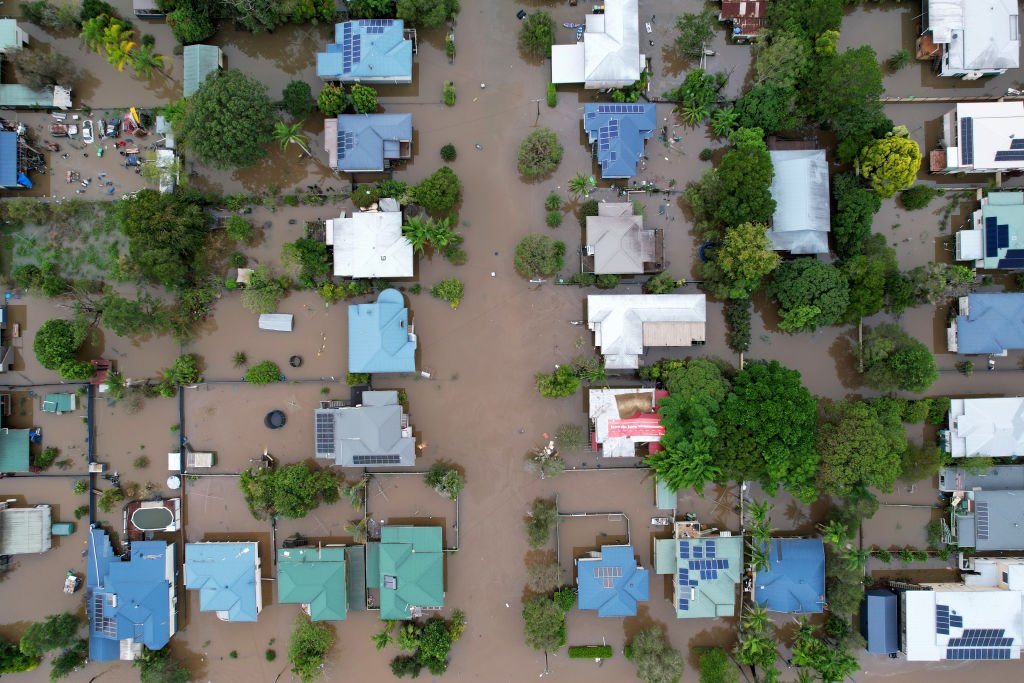The top 10 Australian locations at highest flood and bushfire risk
A new report finds higher flood and bushfire property premiums are leaving more homeowners and investors struggling to insure their assets
More extreme weather events are affecting property values and home insurance costs, with a new report highlighting the impact of bushfire, riverine flooding and coastal erosion risk on homes and the need for buyers to assess disaster risk in their purchasing processes.
The 2024 Perils Report from Domain Research has found there is a direct relationship between the value of a home and its susceptibility to natural disasters. It revealed that 5.6 million Australian homes are at risk of bushfire — almost half of the entire residential housing stock. More than 32,000 homes, or 0.3 percent of stock, have high bushfire risk ratings. The researchers estimate that a home’s value decreases by 2 percent with every increase in its bushfire rating.
The report also found that 953,000 homes, or 8.1 percent of housing stock, face flood risk. Almost 141,000 homes have a high risk, and for every percentage point increase in the risk of a 50-centimetre flood, a property’s value drops by 0.8 percent. About 160,000 homes are within 150 metres of the coastline, and about one in 10 are at risk of erosion. However, the report finds there is no significant price impact given buyers place a high priority on waterside locations and views.
“This report is almost like a snapshot in time, looking at what is that landscape currently today, but we know that these natural disasters are escalating because of climate change,” said Domain chief of research and economics, Dr Nicola Powell. “The impacts in the future could [be] greater, impacting more homes and communities.”
Domain Research said evaluating a property’s risk is increasingly important for buyers. Home purchasers can access information from local councils and state governments, and some information may be included in the contract of sale. Buyers can also pay for a risk report to be done.
A recent report by the National Housing Supply and Affordability Council described climate change as an ‘emerging trend’ affecting values and insurance costs. “The price differential between flood-affected and non-flood affected homes has been estimated to be up to 35 percent a year after a flooding event,” the report said. “Furthermore, the RBA estimates around 7.5 percent of properties are in areas that could experience price falls of at least 5 percent due to climate change by 2050.”
The report said more than one million households are struggling to afford home insurance today, and more homes are uninsured as a result. The Insurance Council of Australia (ICA) says premiums are rising due to the impact of more severe natural disasters and a significant increase in construction costs that have gone well above the rate of inflation, making repairs more expensive.
The ICA said four declared insurance events in 2022 alone resulted in 302,000 claims costing $7.28 billion in insured losses. Six billion was from a single event – the Northern NSW and South-East Queensland floods – which was the second costliest insured event in the world that year and the costliest insured event in Australia’s history.
ICA CEO Andrew Hall says governments at all levels need to invest in more protection measures to mitigate the impact of extreme weather, thereby helping to keep insurance premiums lower.
“Governments must also amend land use planning legislation to include a mandatory requirement for planning approvals to consider property and community resilience to extreme weather, and improve building codes so future homes are made more resilient,” Mr Hall said.
Top 10 areas with the highest chance of a 50cm flood per year
1 Ballina NSW 3.9 percent
2 Tweed Heads South NSW 3.7 percent
3 Grafton NSW 2.7 percent
4 Coonamble NSW 2.3 percent
5 Tweed Heads NSW 2.2 percent
6 York-Beverley WA 1.9 percent
7 Maclean-Yamba-Iluka NSW 1.9 percent
8 Lismore NSW 1.8 percent
9 Tingalpa QLD 1.7 percent
10 Far South West QLD 1.6 percent
Source: Domain Research
Top 10 areas with the highest bushfire risk (out of 10) per year
1 Upper Yarra Valley VIC 7.7
2 Ashendon-Lesley WA 5.5
3 Mount Dandenong-Olinda VIC 5.4
4 Ettrema-Sassafras-Budawang NSW 4.6
5 Mount Wellington TAS 4.3
6 Glen Forrest-Darlington WA 4.0
7 Bilpin-Colo-St Albans NSW 3.9
8 Calga-Kulnura NSW 3.9
9 Deua-Wadbilliga NSW 3.9
10 Belgrave-Selby VIC 3.8
Source: Domain Research
This stylish family home combines a classic palette and finishes with a flexible floorplan
Just 55 minutes from Sydney, make this your creative getaway located in the majestic Hawkesbury region.
Along with high inflation and weak consumer spending, there’s another key factor pushing a record number of businesses to the edge
More than 10,000 companies are expected to have entered external administration by the end of the 2024 financial year, a level not seen for more than a decade. Data just released by the Australian Securities & Investments Commission (ASIC) shows 1,245 companies became insolvent in May, the highest monthly number this financial year. At present, a total of 9,988 businesses have gone bust in FY24 with data from June yet to be finalised.
Deloitte Access Economics Partner David Rumbens said the surge in business insolvencies this year was a “clear sign of economic distress”.
He commented: “[ASIC] predicts that by the end of the financial year, the number of companies entering external administration will likely exceed 10,000 – a level not seen since 2012-13, in the aftermath of the Global Financial Crisis (GFC).”
Mr Rumbens said the elements contributing to this year’s surge in insolvencies include high inflation and interest rates, weak consumer spending, and the commencement of more proactive tax debt collection activities by the Australian Taxation Office (ATO).
“One of the key factors contributing to this surge in insolvencies is the [ATO] pursuing debts that were previously put on hold during the COVID-19 pandemic,” he said.
Mr Rumbens cited ATO figures showing collectable debt rose 89 percent in the four years to June 2023. This has particularly impacted small businesses, which account for approximately 65 percent of the total debt owed at about $33 billion. “But more strictly enforced debt collection is coming at a time of tough economic conditions. High interest rates and cost-of-living pressures have weakened consumer spending, particularly in more discretionary components of spending.”
The construction sector has seen the highest number of insolvencies by far in FY24, mirroring the trend of FY23. Of the 9,988 insolvencies to date, 2,711 of them are in the building sector, which faces several challenges. These include a substantial lift in the cost of construction materials that is well above inflation and has made many fixed-price contracts signed within the past few years unprofitable. There is also a significant labour shortage that is delaying new home completions and new project starts, and also adding higher costs to projects.
“The construction sector has been hit particularly hard, with construction firms leading industry insolvencies in every quarter since mid-2021,” Mr Rumbens said. “They have accounted for approximately 25 percent of all insolvencies during this period. The residential construction sector is already facing a backlog of projects to complete as a result of skills and material shortages in recent years, and increased insolvencies in the sector may only exacerbate the problem of housing shortages.”
The ASIC data shows the next biggest industry affected is ‘other services’, which includes a broad range of personal care services such as hair, beauty, dietary, and death care services. The sector has seen 939 insolvencies in FY24. Retail trade is next with 687 insolvencies, followed by professional, scientific and technical services with 585 insolvencies.
“The food & accommodation sector has also experienced a wave of insolvencies. High input costs, worker shortages, and weak consumer sentiment have put pressure on businesses. Specifically, in March, cafés, restaurants, and takeaway businesses accounted for 5.5 percent of total business insolvencies, the highest proportion in the last three years.”
Mr Rumbens pointed out that while the number of insolvencies was high, it represents a lower share of the business sector at 0.33 percent than it did in FY13 when it was 0.53 percent. “This reflects the increase of registered companies in Australia, which has risen from just over two million to 3.3 million since 2012-13. Even so, the continued lift in insolvencies since 2021 highlights the difficult conditions many businesses face at present.”
This stylish family home combines a classic palette and finishes with a flexible floorplan
Just 55 minutes from Sydney, make this your creative getaway located in the majestic Hawkesbury region.

















